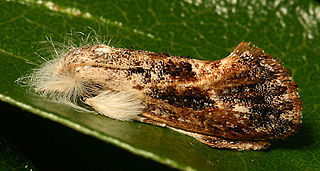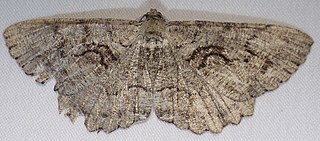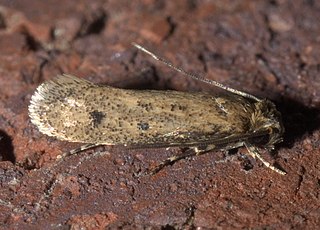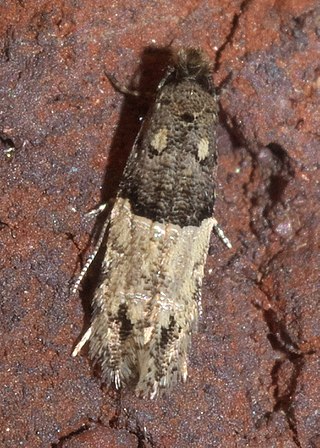
The Noctuidae, commonly known as owlet moths, cutworms or armyworms, are a family of moths. They are considered the most controversial family in the superfamily Noctuoidea because many of the clades are constantly changing, along with the other families of the Noctuoidea. It was considered the largest family in Lepidoptera for a long time, but after regrouping Lymantriinae, Catocalinae and Calpinae within the family Erebidae, the latter holds this title now. Currently, Noctuidae is the second largest family in Noctuoidea, with about 1,089 genera and 11,772 species. This classification is still contingent, as more changes continue to appear between Noctuidae and Erebidae.

Mimallonidae Burmeister (mimallonids), sometimes known as "sack-bearer" moths for the larval case-building behavior, are a family of Lepidoptera containing over 300 named species in 43 genera. These moths are found only in the New World, with most taxa occurring in the Neotropics. Adult moths are externally similar to those belonging to some of the other Macroheterocera families Bombycoidea and Drepanoidea, and thus have been variously treated as belonging to either one of these or other superfamilies.

Acrolophinae is a family of moths in the order Lepidoptera. The subfamily comprises the burrowing webworm moths and tube moths and holds about 300 species in five genera, which occur in the wild only in the New World. It is closely related to the family Tineidae.
Bendisodes is a monotypic moth genus in the family Erebidae erected by George Hampson in 1924. Its only species, Bendisodes aeolia, was described by Druce in 1890. It is found in North America.
Homolagoa is a monotypic moth genus of the family Noctuidae. Its only species, Homolagoa grotelliformis, is found in North America. Both the genus and species were first described by William Barnes and James Halliday McDunnough in 1912.
Hyperepia is a monotypic moth genus of the family Noctuidae erected by William Barnes and Arthur Ward Lindsey in 1922. Its only species, Hyperepia jugifera, was first described by Harrison Gray Dyar Jr. in 1920. It is found in North America.

Cymatophora is a genus of moths in the family Geometridae erected by Jacob Hübner in 1812. It is monotypic, being represented by the single species, the giant gray moth. It is found mostly in the south-eastern United States. It is found in North America.

Hemimorina is a monotypic moth genus in the family Geometridae. Its only species, Hemimorina dissociata, is found in North America. Both the genus and species were first described by James Halliday McDunnough in 1941.

Holochroa is a monotypic moth genus in the family Geometridae. Its only species, Holochroa dissociarius, is found in North America. The species was described by George Duryea Hulst in 1887 and he described the genus nine years later in 1896.
Hymenodria is a monotypic moth genus in the family Geometridae erected by James Halliday McDunnough in 1954. Its only species, Hymenodria mediodentata, was first described by William Barnes and McDunnough in 1911. It is found in North America.

Odontoptila is a monotypic moth genus in the family Geometridae described by Warren in 1897. Its only species, Odontoptila obrimo, was first described by Druce in 1892. It is found in Central and North America.
Paota is a monotypic moth genus in the family Geometridae described by George Duryea Hulst in 1896. Its only species, Paota fultaria, was first described by Augustus Radcliffe Grote in 1882. It is found in North America.

Plataea is a genus of geometrid moths in the family Geometridae. There are about 11 described species in Plataea.

Snowia is a monotypic moth genus in the family Geometridae. Its only species, Snowia montanaria, is known from North America. Both the genus and species were first described by Berthold Neumoegen in 1884. It is found in North America.
Notela is a monotypic moth genus of the family Notodontidae. Its only species, Notela jaliscana, is found in North America. Both the genus and species were first described by William Schaus in 1901

Erannis vancouverensis is a species of geometrid moth in the family Geometridae.

Monopis dorsistrigella, the skunkback monopi, is a species of clothes moth in the family Tineidae.

Niditinea orleansella is a species of clothes moth in the family Tineidae.

Oenoe hybromella is a species of clothes moth in the family Tineidae.

Elaphria exesa, the exesa midget moth, is a species of cutworm or dart moth in the family Noctuidae. It is found in North America.













